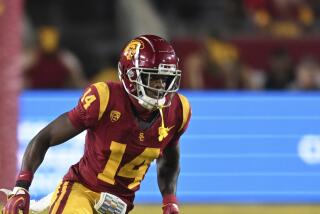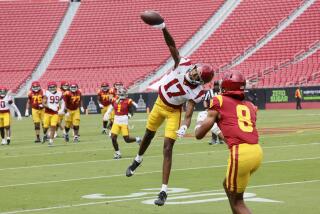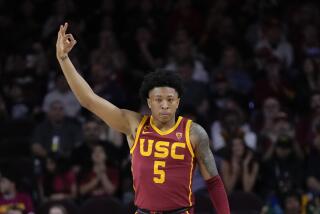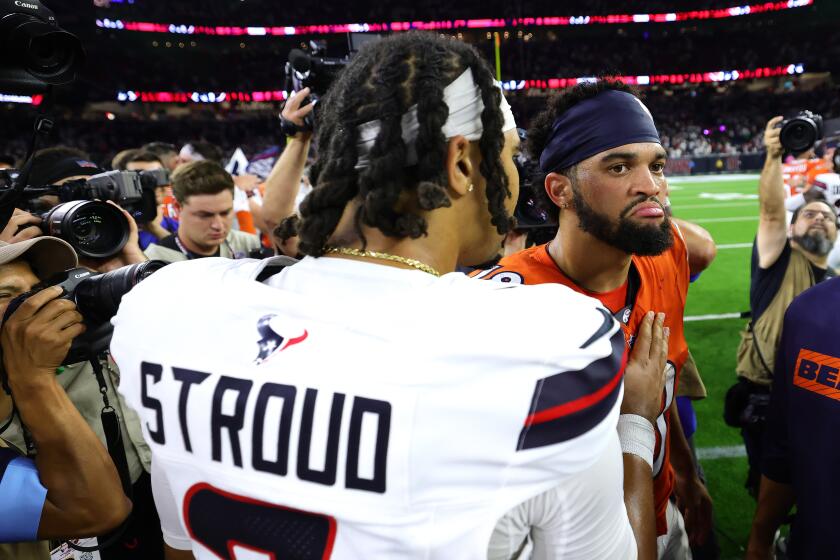USC’s Marqise Lee doesn’t want to rest on his laurels, or in games
Marqise Lee requests no extended breaks, or even a breather.
A one-play respite here, another there. Nothing more.
“I’m not injured or anything,” USC’s multipurpose star says, “and I can run for days. . . . So I’m going to stay out there.”
So far, Lee has mostly stayed out of harm’s way while making the most of his opportunities as a receiver and kick returner.
Two weeks ago against Arizona, the sophomore receiver caught 16 passes for 345 yards while amassing 469 all-purpose yards. He followed that with 12 catches for 157 yards while totaling 408 all-purpose yards against Oregon.
Those performances vaulted the 6-foot, 195-pound Lee from the periphery of the Heisman Trophy discussion onto the short list for a trip to New York in December.
“You could easily argue he’s the most dynamic player in college football right now,” USC Coach Lane Kiffin says.
Lee enters Saturday’s game against Arizona State as the national leader in all-purpose yardage, averaging 223 yards a game. He has scored 13 touchdowns and ranks second nationally with averages of nearly 10 receptions and 143 yards receiving a game. He has averaged 29.4 yards per kickoff return, which ranks 11th.
Stanford Coach David Shaw said Tuesday that Lee was the best college receiver he has seen since Randy Moss.
First-year Arizona State Coach Todd Graham is similarly impressed: “He can take it to the house any time he puts his hands on the ball.”
Lee shrugs off mentions of his stats or exploits, saying that he simply takes advantage of defenses that must account for junior receiver Robert Woods, an All-American last season.
“The coaches give you great opportunities to present yourself,” Lee says, “and give you the right plays to make the numbers.”
Kiffin makes no apologies for Lee’s workload, even though many of his opportunities have come at Woods’ expense. Lee has 88 receptions and has caught more than 10 passes in a game six times. Woods, with 59 receptions, has reached double figures only once.
“As a USC fan, I wouldn’t be real excited if the ball wasn’t going to Marqise Lee very much,” Kiffin says. “It wouldn’t say much for our staff.
“Obviously, we do force a lot of balls to him for a reason — because of what he’s done.”
In nine games, Lee has produced 2,007 all-purpose yards. With at least four games remaining, and possibly five, he is on pace to break Heisman Trophy winner Reggie Bush’s USC record of 2,890 yards set in 13 games in 2005. (Heisman winner Marcus Allen averaged a USC-record 223.6 yards in 12 games in 1981).
Heisman winner Barry Sanders of Oklahoma State amassed an NCAA-record 3,250 all-purpose yards in 1988, averaging 295.5 a game.
Though Lee is not a running back like Bush, Allen and Sanders, there are still durability issues.
In the heat at Arizona, Lee took intravenous fluids at halftime. Kiffin said after the game that, in retrospect, he might have spiked the ball on the final ill-fated drive to give the exhausted receiver a chance to rest before the game’s final plays.
Tim Brown, the 1987 Heisman winner at Notre Dame, says Lee’s ability to combine consistent double-digit receiving performances with kick-return duties is “groundbreaking.”
“It’s a heavy load,” says Brown, a receiver and kick returner who played 17 NFL seasons. “I know by the end of my rookie year I was worn out by the time Thanksgiving came.”
The hard part, Brown says, is the kickoff returns.
“It’s not the amount of hits,” he says. “Just one hit can have you walking differently. Obviously, he’s a guy who knows what he’s doing.”
Lee’s role for the Trojans might expand next season when he will be a draft-eligible junior.
Longtime NFL draft expert Gil Brandt likens Lee to Irving Fryar, a multipurpose star at Nebraska who was the No. 1 pick in the 1984 draft.
“If projections mean anything,” Brandt says of Lee, “he’s going to be a top-five pick.”
In the meantime, Lee hopes to help the Trojans end a two-game skid. An off-the-charts performance in a victory would feel far better than those in losses against Arizona and Oregon.
So don’t look for him on the sideline, except perhaps after plays that require length-of-the-field runs.
“I take one play off,” he says, “then I’m good.”
Twitter: @latimesklein
More to Read
Go beyond the scoreboard
Get the latest on L.A.'s teams in the daily Sports Report newsletter.
You may occasionally receive promotional content from the Los Angeles Times.







